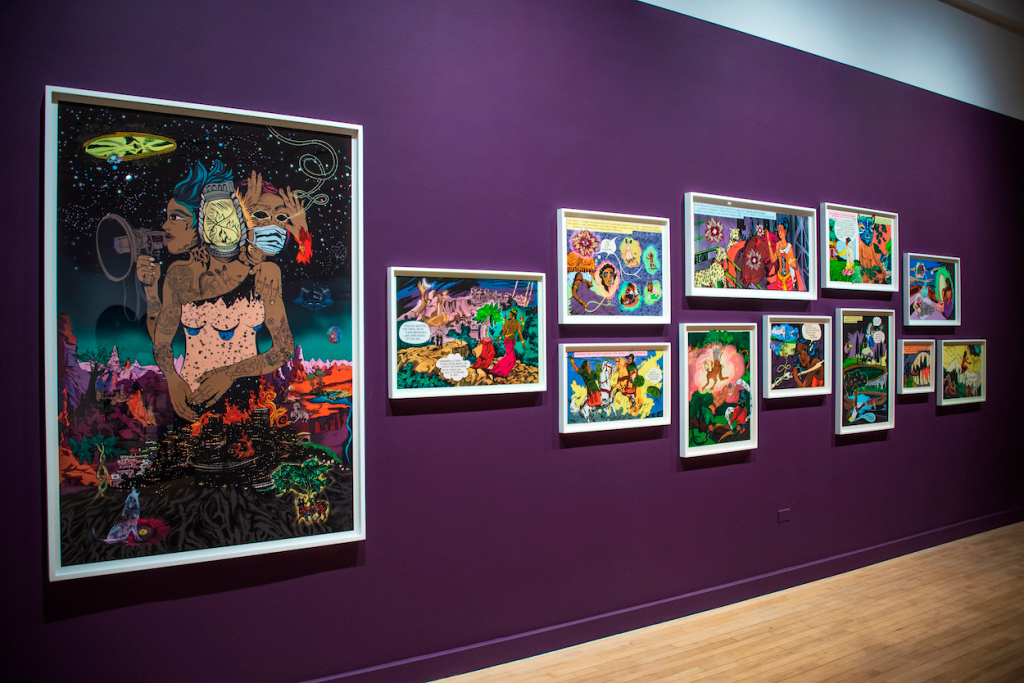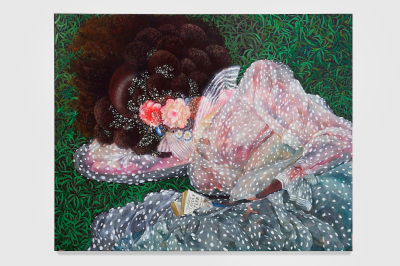 View of “Born in Flames,” 2021, at the Bronx Museum of the Arts, showing paintings by Chitra Ganesh, all 2021. Photo: Becca Guzzo
View of “Born in Flames,” 2021, at the Bronx Museum of the Arts, showing paintings by Chitra Ganesh, all 2021. Photo: Becca Guzzo
Outside the exhibition “Born in Flames: Feminist Futures” is a poetic wall text penned by curator Jasmine Wahi: “You are in the tender belly of the beast. // Cocooned in protective silks. . . . Enveloped in swaths of complexity borne out of a Kali-like maternal instinct:: both coddling and deeply-fiercely protective. // This is the first stop on your journey through an untamed and intersecting space where/when many worlds collide.” Rather than begrudgingly perform the work of most museum writing, this language reflects the visceral materiality and temporal repositioning that define the exhibition.
“Born in Flames” brings together works by fourteen female- and nonbinary-identifying contemporary artists who present speculative narratives concerned with social liberation. The exhibition is rooted in an understanding that imperialism, capitalism, and their racialized machinations have ravaged our world; from there, the works seek to reclaim what might have been and lay the groundwork for what might still be. Its spirit is best articulated in the speech bubble of a wonderfully mutated character in artist Chitra Ganesh’s graphic novel-cum-paintings: “I remember us then: interlocking mazes, the species we once were, & the stories we told, of water and of skin.”
The species we once were. As I got lost inside the galleries, I was struck by the many ways the artists’ work could be interpreted in relation to this phrase. I sensed not just a look back to the past, but, more critically, a look back to a not-yet-lived time from the vantage point of an even more distant horizon. Within a framework of anticipating more mature societies and life-forms, artists made a range of maneuvers. Wangechi Mutu’s assembled sculptures of leathery limbs, a bronze head, and gnarled leg-and-branch hybrids suggest vestiges of alternative figures, half botanical, half human. Saya Woolfalk’s site-specific installation Daishikimono (daywear for lands not yet habitable by human kind), 2021, resembles a giant garment waiting to be removed from the wall and worn when, as the title indicates, we acquire new forms and are prepared to live in another land.
If those examples toy with the “species” we will have been or may someday be, then Caitlin Cherry’s Her Widescreen Tetra (2021) more specifically hints at how differently our evolved selves might see. A kaleidoscopic oil painting framed inside a freestanding metal armature, Cherry’s work reads as a fossilized, expanded field of vision. Partly obscured by a painted moiré design, its rectangular sections present the seemingly rotoscoped faces and bodies of women posing for the camera in a palette evoking thermal imaging techniques. The extensive, dizzying patterning slows and complicates the voyeuristic act of looking while preserving the Black female subjects in this prismatic state.
The potential in rethinking our present from the vantage point of the future perfect is even clearer after viewing filmmaker and activist Lizzie Borden’s 1983 cult classic, which gives the show its title. Set in a not-so-distant future, Born in Flames tracks the stories of several women- and femme-led groups speaking out against sexism and the oppression of women in an allegedly free society after a “Social Democratic War of Liberation” has taken place. The agents range from two pirate radio DJs to a rogue international activist to a group called the Women’s Army. The sly play with documentary conventions combined with the interracial lesbian-led revolt, ’80s post-punk DIY aesthetic, and literal fire at the end make this an ideal roadmap for reenvisioning societal order.
 Firelei Báez, On rest and resistance, Because we love you (to all those stolen from among us), 2020, oil and acrylic on canvas, 48 by 60 in.
Firelei Báez, On rest and resistance, Because we love you (to all those stolen from among us), 2020, oil and acrylic on canvas, 48 by 60 in.
Wandering through the many worlds on display, I kept coming back to the reclining figure in Firelei Báez’s painting On rest and resistance, Because we love you (to all those stolen from among us), 2020. The character lies on a bed of grass with her head resting on a bent arm and flowers growing over her face. Baez’s treatment of the hair—elaborately coiffed into delicate tufts and thin strands—mimics the forms in the bouquet. Perhaps most important, a copy of Octavia Butler’s prescient Parable of the Sower is tucked into her lap. This book seemed to have transported her to some oasis resembling the one at the end of Butler’s novel. Or had she, like the story’s Earthseed group, found the place full of skeletons, scorched and looted, and used the book as a guide to build it into this paradise? If necessary, her diaphanous tulle garment could enshroud her like the “protective silks” of Wahi’s text. Her one visible eye projects a resolute gaze—a beacon signaling us to follow her to this other future.
Source link : https://www.artnews.com/art-in-america/aia-reviews/born-in-flames-bronx-museum-arts-1234600537












